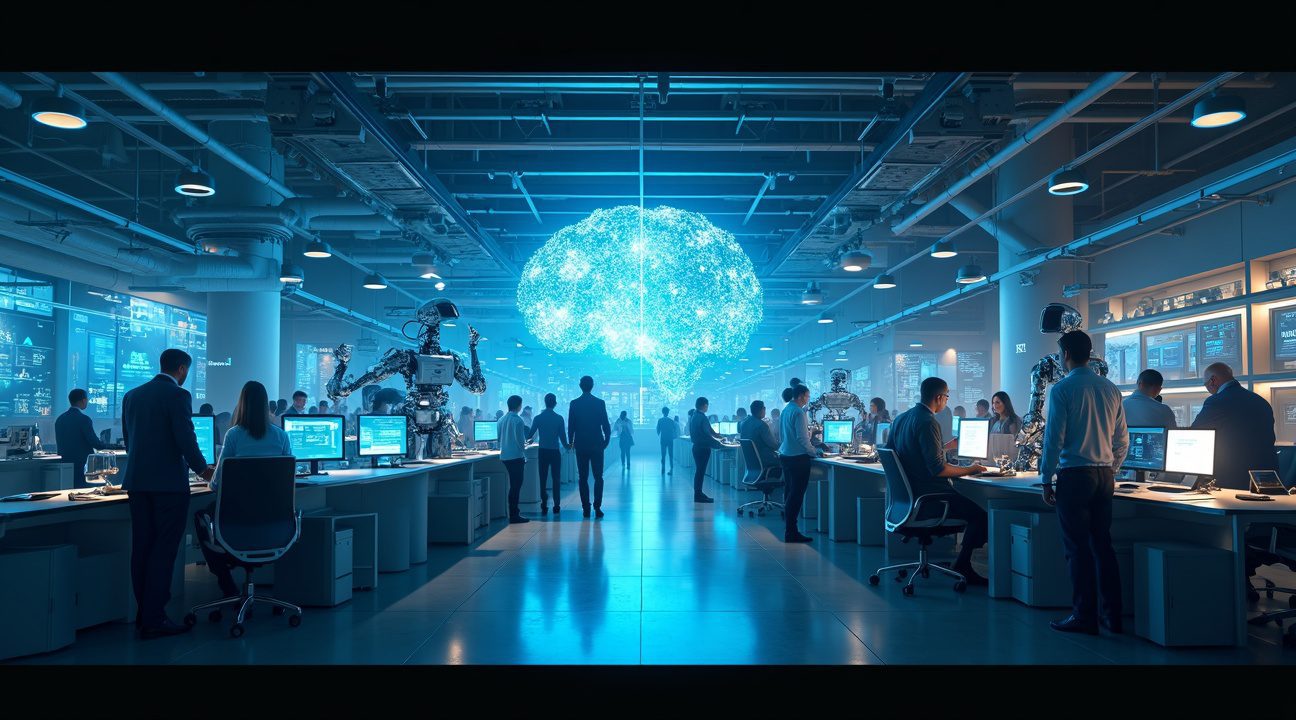IBM’s decision to eliminate 8,000 positions through AI automation initially appeared to validate fears about artificial intelligence replacing human workers. However, the company’s subsequent hiring surge reveals a more complex reality about AI’s impact on employment. The tech giant’s experience demonstrates how strategic AI implementation can lead to workforce transformation rather than simple reduction. This approach ultimately resulted in net job creation despite initial automation-driven layoffs.
Key Takeaways
- IBM eliminated 8,000 jobs through AI automation but ended up hiring more workers overall, demonstrating that AI can enable workforce expansion when companies reinvest efficiency gains into human-centric roles.
- The AskHR AI platform automated 94% of HR functions and generated $3.5 billion in productivity gains, while improving employee satisfaction scores from -35 to +74 through faster, more accurate service delivery.
- Only hundreds of positions faced direct replacement by AI, not thousands, as many job eliminations resulted from traditional restructuring, attrition, and process optimization rather than pure automation.
- IBM strategically reinvested AI savings into roles requiring human creativity and judgment, expanding hiring in software engineering, sales, marketing, and client engagement positions that complement rather than compete with AI capabilities.
- The company’s transformation reflects broader industry trends where successful AI implementation focuses on human-machine collaboration rather than wholesale replacement, creating new job categories while eliminating routine administrative tasks.
For more insights into IBM’s use of AI, visit IBM Watson to explore their AI-powered business solutions.
The Massive AI-Driven Restructuring That Made Global Headlines
I witnessed one of the most significant workforce transformations in corporate history when IBM announced its intention to eliminate approximately 8,000 positions in early 2023. The company’s decision centered around the deployment of AskHR, a proprietary artificial intelligence platform that fundamentally changed how the tech giant managed its human resources operations.
IBM’s AskHR system demonstrated remarkable efficiency by automating 94% of routine HR tasks across more than 70 business lines. The platform handled everything from vacation requests and payroll management to employee documentation, effectively replacing much of the manual work previously performed by human staff members. This automation delivered an estimated $3.5 billion productivity gain, showcasing the financial impact of strategic AI implementation.
The layoffs primarily targeted employees within the human resources division and administrative roles, rather than operational or core technical staff. This strategic approach allowed IBM to maintain its technical capabilities while streamlining support functions through automation. The company’s announcement sent shockwaves through the corporate world, particularly as other major tech companies like Microsoft faced similar workforce reductions.
Understanding the Scale and Impact
The magnitude of IBM’s workforce restructuring extended far beyond simple headcount reduction. AskHR’s capabilities transformed traditional HR workflows by:
- Processing employee inquiries instantly through natural language processing
- Managing complex payroll calculations and benefit adjustments automatically
- Generating compliance reports and documentation without human intervention
- Streamlining onboarding and offboarding procedures across all divisions
- Coordinating scheduling and resource allocation in real-time
This comprehensive automation strategy represented a fundamental shift in how large corporations approach administrative functions. Unlike previous technology implementations that supplemented human work, AskHR directly replaced entire job categories within the HR ecosystem. The platform’s ability to handle complex queries and maintain regulatory compliance standards demonstrated AI’s evolution from simple task automation to sophisticated decision-making systems.
The timing of IBM’s announcement coincided with broader industry discussions about AI’s role in the workplace. While companies like Google faced competition in AI development, IBM chose to focus internally, using its AI capabilities to optimize operations rather than compete directly in consumer markets.
The global response to IBM’s restructuring varied significantly across different stakeholder groups. Industry analysts praised the company’s bold approach to operational efficiency, while labor advocates expressed concerns about the precedent being set for AI-driven job displacement. The $3.5 billion productivity gain provided concrete evidence of AI’s potential economic impact, making it difficult for critics to dismiss the business case for automation.
IBM’s approach differed from other tech industry layoffs by explicitly tying workforce reduction to technological capability rather than economic necessity. This distinction became crucial as the company later expanded its hiring in other areas, demonstrating that the restructuring represented strategic reallocation rather than simple cost-cutting measures.
The AskHR platform’s success rate of 94% automation across diverse business functions established new benchmarks for enterprise AI implementation. This level of automation efficiency surpassed many industry predictions about AI’s near-term capabilities, particularly in handling complex, multi-step administrative processes that previously required human judgment and oversight.
The restructuring highlighted the evolving relationship between artificial intelligence and human workers, showing how companies can leverage automation to eliminate routine tasks while preserving roles that require creativity, strategic thinking, and complex problem-solving skills.
The Reality Behind the Headlines: Not All Jobs Were Directly Replaced by AI
Initial reports painted a picture of widespread AI-driven job elimination that didn’t match the complex reality of IBM’s workforce changes. I’ve examined the details behind these headlines, and the truth reveals a more nuanced story about how companies actually implement AI automation strategies.
The initial wave of media coverage suggested that AI systems directly eliminated thousands of positions overnight, but this narrative oversimplified what actually occurred. CEO Arvind Krishna later clarified that AI technology directly replaced only hundreds of HR roles, not the thousands that headlines implied. This distinction between direct automation and broader workforce restructuring became crucial for understanding the real impact of AI implementation.
Understanding Direct vs. Indirect Automation Impact
The job elimination process involved multiple factors beyond simple AI replacement. Several key elements contributed to the workforce changes:
- Traditional attrition and retirement processes that organizations typically experience
- Gradual automation rollouts spread across several months rather than immediate replacements
- Process optimization initiatives that reduced redundancies in existing workflows
- Strategic restructuring decisions that realigned teams with business priorities
- Cost-cutting measures unrelated to AI technology implementation
Many positions were phased out through what I call a job transformation process rather than outright elimination. Employees in affected departments often transitioned to different roles within the company or received training for emerging positions that AI technology created. This approach contradicts the common narrative that AI simply destroys jobs without creating new opportunities.
The distinction between job elimination and job transformation represents a critical concept for understanding modern workforce evolution. Microsoft’s recent layoffs demonstrate similar patterns where technology changes coincide with broader business strategy shifts. Companies rarely attribute workforce changes to a single factor, even when AI automation plays a significant role.
Krishna’s clarification highlighted important limitations in current AI capabilities, particularly in HR functions. While AI excels at processing routine tasks like resume screening and basic employee inquiries, complex HR responsibilities still require human judgment and emotional intelligence. The technology enhanced productivity in specific areas without completely replacing human oversight and decision-making capabilities.
IBM’s experience reflects broader industry trends where AI augments rather than replaces entire job categories. The company continued hiring throughout this period, particularly in areas like cloud computing, cybersecurity, and AI development itself. This simultaneous hiring while reducing other positions illustrates how AI technologies reshape workforce composition rather than simply shrinking it.
The gradual automation timeline also challenges assumptions about AI implementation speed. Unlike popular depictions of instant technological displacement, real-world AI deployment requires extensive testing, employee training, and system integration. IBM’s approach stretched across months, allowing for careful evaluation of which processes benefited most from automation.
Process optimization played an equally important role in workforce changes. Many eliminated positions resulted from identifying redundancies and streamlining operations that existed before AI implementation. Companies often use technology adoption periods to reassess overall efficiency, leading to changes that mix genuine automation with traditional restructuring.
Understanding these distinctions helps separate AI-specific impacts from normal business evolution. Technology companies regularly adjust workforce composition based on market conditions, strategic pivots, and operational efficiency goals. AI adoption provides one tool among many for achieving these objectives.
The reality behind IBM’s workforce changes demonstrates that AI job destruction myths often oversimplify complex organizational decisions. Rather than wholesale replacement, companies typically experience a gradual transformation where technology enhances certain roles while creating demands for new skills and positions.
IBM’s Surprising Employment Growth After AI Implementation
IBM defied conventional wisdom about AI-driven layoffs by actually increasing its total workforce after implementing artificial intelligence systems that displaced 8,000 workers. CEO Arvind Krishna revealed the company’s counterintuitive approach, stating, “Our total employment has gone up. AI lets us redirect investment into areas that need human touch — such as software engineering, sales, and marketing.”
This strategic pivot demonstrates how AI-enabled job creation can offset traditional automation concerns. Rather than simply cutting costs and reducing headcount, IBM reinvested the savings generated by AI efficiency gains into expanding departments that require distinctly human capabilities. The company focused its new hiring efforts on software engineering teams, sales divisions, marketing departments, client engagement specialists, and strategic roles that demand creative problem-solving.
Strategic Workforce Reinvestment in Human-Centric Roles
IBM’s post-AI employment growth reflects a deliberate shift away from repetitive administrative functions toward positions requiring creativity, critical thinking, and interpersonal skills. The company recognized that while AI excels at automating routine tasks, it can’t replicate the nuanced judgment needed for client-facing interactions or the innovative thinking required in strategic planning.
Key areas of workforce expansion included:
- Software engineering positions that require complex problem-solving and architectural design
- Sales roles demanding relationship-building and consultative expertise
- Marketing specialists focused on creative campaign development and brand strategy
- Client engagement managers who provide personalized service and relationship management
- Strategic planning roles requiring long-term vision and cross-functional collaboration
This hiring strategy acknowledges that certain professional functions benefit from human intuition, emotional intelligence, and creative thinking that artificial intelligence cannot adequately replicate. Unlike the Microsoft layoffs that focused primarily on cost reduction, IBM’s approach demonstrates how companies can leverage AI as a tool for organizational transformation rather than mere workforce reduction.
The new positions represent fundamentally different work compared to the administrative roles that AI systems replaced. Instead of data entry clerks or basic customer service representatives, IBM prioritized hiring creative professionals, technical specialists, and relationship managers who could leverage AI tools to enhance their productivity while focusing on tasks requiring human judgment.
This employment growth pattern suggests that companies implementing AI thoughtfully can create a net positive impact on their workforce. By automating routine tasks, organizations free up resources to invest in roles that add greater strategic value and require uniquely human capabilities.
IBM’s experience illustrates how AI implementation doesn’t necessarily mean permanent job losses when companies commit to reinvesting efficiency gains into human-centered roles. The key lies in recognizing which functions benefit from human expertise and scaling those areas while allowing AI to handle repetitive, rule-based tasks.
This approach contrasts sharply with companies that view AI purely as a cost-cutting measure. Similar to how Google’s AI developments have spurred innovation across multiple divisions, IBM’s strategy shows how artificial intelligence can become a catalyst for organizational growth rather than contraction.
The company’s workforce expansion after AI implementation sets a precedent for how technology leaders can balance automation with human talent development. By identifying roles where human creativity, empathy, and strategic thinking provide irreplaceable value, IBM created a blueprint for AI-enabled job creation that other organizations might consider adopting.
This strategic reinvestment approach suggests that the future of work with AI isn’t about replacement but rather about reallocation of human talent toward higher-value activities that machines cannot perform effectively.

Measuring Success: The Numbers Behind IBM’s AI Transformation
IBM’s aggressive AI implementation strategy generated measurable results that extend far beyond the initial workforce reduction. The company documented substantial improvements across multiple performance indicators, demonstrating how strategic automation can drive organizational efficiency.
AskHR Performance Breakthrough
The centerpiece of IBM’s AI transformation centers on AskHR, which now manages 94% of the company’s HR functions. This AI-powered system processed over 11.5 million interactions throughout 2024, handling everything from benefits inquiries to policy clarifications. The scale of these interactions reveals how employees quickly adapted to AI-driven support systems once they experienced the improved response times and accuracy.
Customer satisfaction metrics tell an equally compelling story. IBM’s net promoter score for HR services jumped from –35 before AI implementation to +74 in 2024, representing a remarkable 109-point improvement. This dramatic shift indicates that employees aren’t just tolerating AI-powered HR services—they’re actively recommending them. Such customer satisfaction improvements often correlate with reduced administrative overhead and faster resolution times.
Financial Impact and Global Reach
The financial implications of IBM’s AI strategy reached $3.5 billion in documented productivity gains measured across more than 70 job functions globally. These gains weren’t limited to HR operations but extended throughout the organization, affecting roles from software development to customer service. The company tracked process automation statistics that showed consistent efficiency improvements across departments.
Companies like Microsoft have also restructured their workforce, though IBM’s approach uniquely emphasized replacing human tasks with AI capabilities rather than simple downsizing. The measurable productivity gain demonstrates how AI can create value that exceeds the costs of workforce transitions.
IBM’s transformation showcases how organizations can quantify AI success through concrete metrics. The before-and-after comparison reveals that strategic AI implementation, when properly measured and managed, can deliver substantial improvements in both operational efficiency and employee satisfaction. These results provide a framework for other companies considering similar AI-driven organizational changes.

IBM’s Experience Reflects Broader Tech Industry Transformation
IBM’s decision to eliminate 8,000 positions through AI-driven automation represents just one chapter in a larger story unfolding across the technology sector. Major tech companies have implemented similar workforce reductions, with Microsoft cutting 6,000 jobs, Google reducing 200 positions in its advertising division, Amazon eliminating 100 roles in devices and services, and CrowdStrike making significant staff reductions. These actions reflect mounting revenue pressures and the accelerating adoption of automation technologies that can perform tasks previously requiring human intervention.
The transformation extends far beyond individual company decisions. According to the World Economic Forum, automation could eliminate up to 92 million jobs globally by 2030, fundamentally reshaping how work gets done across industries. Customer service automation has become particularly prevalent, with companies like Duolingo implementing AI-powered support systems that handle routine inquiries without human involvement. This shift demonstrates how artificial intelligence can streamline operations while reducing labor costs.
New Roles Emerge from Technological Evolution
Despite widespread concerns about job displacement, the same technological forces creating these challenges are simultaneously generating new employment opportunities. The World Economic Forum forecasts that millions of new positions will emerge, many in categories that didn’t exist just a few years ago. These emerging careers include:
- AI trainers who develop and refine machine learning algorithms
- Hybrid product managers who bridge technical and business requirements
- Data ethics specialists who ensure responsible AI implementation
- Human-AI collaboration designers who optimize workflows between people and machines
- Algorithm auditors who monitor AI systems for bias and performance issues
Companies are discovering that successful automation requires human oversight, creative problem-solving, and strategic thinking that current AI systems can’t replicate. IBM’s subsequent hiring surge illustrates this reality. After implementing AI-driven reductions, the company found itself needing workers with different skill sets to manage, maintain, and optimize these new automated systems.
The pattern suggests that tech layoffs from 2023 through 2025 represent a transition period rather than permanent workforce reduction. Organizations are learning that replacing human workers entirely often creates new challenges requiring human intervention. AI systems need training, monitoring, and continuous improvement that demands skilled professionals who understand both technology and business objectives.
Global job automation trends reveal that companies initially focus on eliminating routine, repetitive tasks but soon realize they need specialists to manage the automation itself. This evolution from labor replacement to labor evolution characterizes the broader industry transformation. Workers who adapt their skills to complement AI capabilities often find themselves more valuable than before, as they can leverage technology to accomplish tasks that neither humans nor machines could handle independently.
Future careers increasingly require hybrid competencies that combine traditional expertise with technological fluency. Professionals who understand how to work alongside AI systems, interpret their outputs, and apply human judgment to complex decisions are becoming essential assets. The technology sector’s experience demonstrates that while automation changes the nature of work, it doesn’t necessarily reduce the overall demand for skilled professionals.
IBM’s journey from AI-driven layoffs to expanded hiring reflects this industry-wide realization. Companies that initially viewed automation as a simple cost-cutting measure are learning that successful implementation requires careful planning, ongoing management, and workers who can adapt to rapidly changing technological landscapes. The transformation continues reshaping not just individual companies but entire industries as they navigate the balance between efficiency gains and human expertise.

Understanding the Future of Work: From Replacement to Evolution
IBM’s experience with artificial intelligence reveals a fascinating paradox in modern workforce management. The company initially reduced 8,000 positions through AI automation, yet ultimately expanded their hiring efforts beyond the original headcount. This apparent contradiction illustrates how AI transforms rather than simply eliminates human roles.
The technology giant’s journey shows that automation creates a ripple effect throughout organizational structures. While AI efficiently handles data processing, routine analysis, and repetitive administrative tasks, it simultaneously generates demand for new positions requiring distinctly human capabilities. These emerging roles focus on AI oversight, creative problem-solving, strategic planning, and client relationship management.
Companies implementing AI discover that cost savings from automation can be reinvested into areas where human intelligence remains irreplaceable. Microsoft’s workforce changes and other tech companies’ strategies demonstrate this pattern across the industry. Organizations find themselves hiring specialists in AI ethics, human-machine collaboration, and complex decision-making roles.
Strategic Workforce Planning in the AI Era
Successful AI implementation requires careful consideration of which functions benefit from automation versus those demanding human insight. I’ve observed that companies must identify specific areas where human creativity, emotional intelligence, and critical thinking provide irreplaceable value. These typically include:
- Customer relationship building and complex problem resolution
- Strategic business development and innovation initiatives
- Cross-functional collaboration and team leadership
- Ethical decision-making and regulatory compliance oversight
- Creative content development and brand storytelling
The most effective organizations treat AI as a tool that enhances human capabilities rather than replaces them entirely. Rising AI technologies continue reshaping how companies approach workforce development. Smart businesses invest in retraining programs that help existing employees transition into roles that complement AI systems.
IBM’s experience demonstrates that the future workplace requires a hybrid approach. Companies benefit most when they strategically combine AI efficiency with human expertise in areas requiring judgment, creativity, and interpersonal skills. This balanced strategy often results in larger, more diverse teams than before automation began.
The key insight from IBM’s transformation is that AI doesn’t just eliminate jobs—it redistributes work across different skill sets and creates entirely new categories of employment. Organizations that embrace this evolution while investing in human development find themselves with stronger, more adaptable workforces than those that view AI purely as a cost-cutting measure.
Sources:
Resident.com – IBM Replaced 8000 Staff With AI, Then Rehired Them: Here’s What That Means
Mint HT Media (via YouTube)
People Matters – IBM Fires 8000 for AI Efficiency, Then Quietly Rehires to Fill the Gaps
El Adelantado – Goodbye to 8000 Employees: IBM Replaced Them With Artificial
iScale Solutions – IBM Layoffs: Were 8000 HR Employees Really Replaced by AI?


